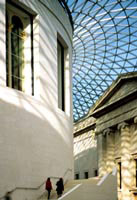The verdict comes in
The British Museum Great Court has been simplified to create a soothing retreat from the claustrophobia of central London

One of the most memorable cultural features of the new millennium has been the creation of new public spaces in London. Herzog de Meuron’s Tate Modern at Bankside, with its phenomenal Turbine Hall, for example, and the external courtyard at Somerset House, by Jeremy Dixon Edward Jones, with its rows of fountains, offer welcome breathing spaces alongside conventional attractions. Now the £100m British Museum Great Court has completed the set.
Foster and Partners’ reconstruction of the Queen Elizabeth II Great Court is a fantastic blend of old and new. As you walk in through the replica of Robert Smirke’s classical South Portico, with its controversial limestone face, you enter a breathtaking space covered by a glazed roof that casts light patterns across the limestone walls. The emptiness of the courtyard, except for purpose-designed circular reception desks on either side of the entrance, elegant metal information totems and the occasional “sculpture” from the museum’s collection, is wonderful.
The centrepiece Рthe famous Reading Room Рis set like a jewel in a new, simple limestone rotunda. Elements of the domed roof and decorative papier m̢ch̩ ceiling can be glimpsed through high-level windows, while wide limestone staircases sweep up on either side of the rotunda to the restaurant and a gallery for temporary exhibitions at the rear. Lighting arranged around the perimeter of the rotunda is the main source of artificial illumination.
The historic book collection has been rehoused in the new British Library at St Pancras, but the Reading Room has been faithfully restored to become the museum’s library, where visitors can find out more about the history of civilisations that the museum collection embodies. The original desks have been restored for visitors to use and the configuration kept, but state-of-the-art computer equipment has been installed to bring the facility up to date.
Commerce inevitably has to sit hand in hand with culture at the Great Court, as with any gallery or museum. But the architects appear to have maintained control over the intervention of the restaurant, the two cafés and three shops, largely by their placing within the scheme.
The high-level main restaurant, with its two private dining areas Рwhich was a mere shell awaiting its franchisee when I visited Рis hidden behind the rotunda, while the caf̩s comprise only a self-service servery at ground level at the back of the space and simple glass-topped tables and metal stools designed by Foster.
The main shop – largely for books – is set beneath the restaurant on the ground floor and features a minimal design by Carte Blanche. The consultancy, responsible also for the British Museum’s two main shops, has also designed the two smaller book shops set into either side of the rotunda. Light coming through the glass frontages is likely to create a discreet beacon, leading visitors there.
Also worth a visit are the underground spaces housing seminar rooms and lecture theatres. But best of all below ground are the vaulted areas for school parties, with their bright, colour-coded lockers and durable refectory-style tables, created with Tecno. The arched brickwork marks a contrast with the cool interior of the court.
But nothing quite compares with that first image of the Great Court itself. The uncluttered space and coherence of the limestone finishes makes it a welcome retreat from the branded bustle of nearby Oxford Street and a triumph of light and space.
The British Museum Great Court, 46 Bloomsbury Street, London WC1, opens to the public on 7 December
-
Post a comment



